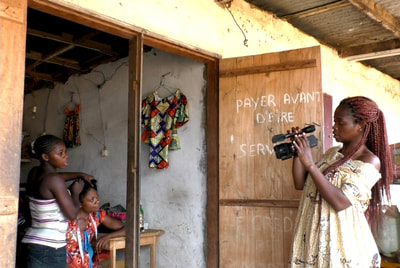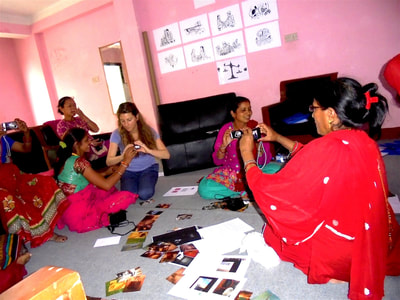Project Name and Responsible
|
Sophie INGLIN, M.A, MPH
Independent Visual Programme Developper Geneva SWITZERLAND Contact: sophie.inglin@hotmail.com |
News 2020
Projet d'éducation par les pairs sur le prolapsus utérin au Népal, la première cohorte de formatrices 2020 est en place! Le projet se poursuit jusqu'en 2023.
Nouvelle exposition Ma Santé, Mon Histoire au Népal, à la maternité des Hopitaux Universitaires de Genève, Suisse, du 6 au 18 Avril 2019.
Vernissage à l UNIGE le 10 Avril 2018
Project Description
Media, such as video or photography, brings communities together and enables their members to discuss, debate, raise awareness and advocate around women’s health issues. Whether through the active or passive participation of women in producing and disseminating visual data, the use of media within public health projects makes it possible to mobilise communities in favour of women’s right and health.
In terms of active participation, Participatory Video and Photovoice are visual techniques that are often used as collaborative tools for community-based participatory research, advocacy and social change. These innovative methods aim to mobilise the capacities of vulnerable or marginalised populations to take part in a collaborative process of collecting, reporting, analysing and disseminating visual content. The participants are thus engaged in the co-creation of knowledge and reinforce empirical evidence about health and well-being by producing visual data using their own identities and life experiences. These methods enable those who are traditionally the subjects of photography or documentary films to become their creators and with the goal of collective action to reach various audiences through exhibitions, prevention actions, or peer health education programmes.
The projects below, especially those in Cameroon and Nepal (in English), allowed women and young girls to generate their own visual materials about the health challenges they are facing and this empowerment offers new evidence on public health and human rights issues.
In terms of active participation, Participatory Video and Photovoice are visual techniques that are often used as collaborative tools for community-based participatory research, advocacy and social change. These innovative methods aim to mobilise the capacities of vulnerable or marginalised populations to take part in a collaborative process of collecting, reporting, analysing and disseminating visual content. The participants are thus engaged in the co-creation of knowledge and reinforce empirical evidence about health and well-being by producing visual data using their own identities and life experiences. These methods enable those who are traditionally the subjects of photography or documentary films to become their creators and with the goal of collective action to reach various audiences through exhibitions, prevention actions, or peer health education programmes.
The projects below, especially those in Cameroon and Nepal (in English), allowed women and young girls to generate their own visual materials about the health challenges they are facing and this empowerment offers new evidence on public health and human rights issues.
Participatory video about unwanted early pregnancies in Cameroon
In Cameroon, it is estimated that 30% of women aged 20-24 brought a child into the world before the age of 18. These pregnancies are multifactorial and have a considerable impact on these young girls in terms of health, education and economic potential. This project has been developed by allowing ten young mothers to create a film, through their own eyes, emotions, opinions and lived experience. These participants created this film with social change in mind, often preceded by the beginnings of personal change. During a twelve-day workshop, the young mothers have exchanged views, discussed and debated about early pregnancies, their causes and individual and social consequences. The group was thus able to draw on emotions to structure their thoughts and the narration of the film. Armed with this experience, the participants collected the voices of fifteen people in different villages and highlighted the various issues raised by teenage pregnancies, while being fully aware of the challenges imposed by the technical process of filmmaking. This film (26 minutes) is used as an awareness tool by a local NGO, defending the interests of girl-mothers with support, education and empowerment.
In Cameroon, it is estimated that 30% of women aged 20-24 brought a child into the world before the age of 18. These pregnancies are multifactorial and have a considerable impact on these young girls in terms of health, education and economic potential. This project has been developed by allowing ten young mothers to create a film, through their own eyes, emotions, opinions and lived experience. These participants created this film with social change in mind, often preceded by the beginnings of personal change. During a twelve-day workshop, the young mothers have exchanged views, discussed and debated about early pregnancies, their causes and individual and social consequences. The group was thus able to draw on emotions to structure their thoughts and the narration of the film. Armed with this experience, the participants collected the voices of fifteen people in different villages and highlighted the various issues raised by teenage pregnancies, while being fully aware of the challenges imposed by the technical process of filmmaking. This film (26 minutes) is used as an awareness tool by a local NGO, defending the interests of girl-mothers with support, education and empowerment.
Photovoice project on uterine prolapse in Nepal : a peer health education initiative
Uterine prolapse, which is characterized by the descent of the uterus into the vagina, is a major public health problem affecting 10-40% of women living in Nepal. This painful and disabling condition, which is detrimental to health and quality of life, is very widespread in the country where discrimination against women and girls is still strong. This project has been developed by allowing seven farming women suffering from uterine prolapse to contribute to the fight against it by creating their own photo essay, tracing their realities and everyday life. These participants have been enrolled on a one-month workshop that was composed of several phases dedicated to discussions of a broad range of issues, and some sharing of personal experiences. They were also trained in narrative and photographic techniques and fundamental ethical issues before they carried out different data collection activities in their villages. Each round of data collection was followed by exercises related to selection and contextualisation of pictures and codifying issues & themes.
Their first photographic experience resulted in an impactful photo-report on the causes and consequences of uterine prolapse (approved by the Ministry of Health), which has been used to create peer health education materials - adapted to the realities of affected women and to an illiterate public - within the country. New trainers (a core group of women) have been trained to disseminate this material and sensitize communities on uterine prolapse.
Uterine prolapse, which is characterized by the descent of the uterus into the vagina, is a major public health problem affecting 10-40% of women living in Nepal. This painful and disabling condition, which is detrimental to health and quality of life, is very widespread in the country where discrimination against women and girls is still strong. This project has been developed by allowing seven farming women suffering from uterine prolapse to contribute to the fight against it by creating their own photo essay, tracing their realities and everyday life. These participants have been enrolled on a one-month workshop that was composed of several phases dedicated to discussions of a broad range of issues, and some sharing of personal experiences. They were also trained in narrative and photographic techniques and fundamental ethical issues before they carried out different data collection activities in their villages. Each round of data collection was followed by exercises related to selection and contextualisation of pictures and codifying issues & themes.
Their first photographic experience resulted in an impactful photo-report on the causes and consequences of uterine prolapse (approved by the Ministry of Health), which has been used to create peer health education materials - adapted to the realities of affected women and to an illiterate public - within the country. New trainers (a core group of women) have been trained to disseminate this material and sensitize communities on uterine prolapse.
Film « AUX FRONTIERES DE LA VIE : les barrières de l’accès aux soins qualifiés des femmes enceintes au Burkina Faso »
Au Burkina Faso, chaque année, plus de 2000 femmes meurent des suites de complications liées à la grossesse ou à l'accouchement. La lutte contre la mortalité maternelle est aujourd’hui une priorité de santé publique et un impératif social et politique dans le pays. Sur demande du Ministère de la santé du Burkina Faso en 2014, un film à finalité pédagogique a été réalisé par une équipe locale et de nombreux partenaires au développement, et intégré dans le cursus des filières de santé publique et médecine au sein de treize sites d’enseignement du pays. Au cœur de ce film reposent les témoignages de nombreuses femmes dont les difficultés et trajectoires guident le film.
Les buts de ce support audiovisuel visent à permettre aux étudiants i) de mieux cerner les difficultés, les enjeux actuels ainsi que les perspectives d’avenir liés à la santé maternelle et néonatale au Burkina Faso ii) de consolider leur savoir, aiguiser leurs opinions et leur capacité à développer un argumentaire plus solide sur les barrières d’accès aux soins qualifiés des femmes enceintes et iii) d’être sensibilisés à la nature de leur rôle et à l'importance de mettre l'intérêt du patient au centre de leurs préoccupations.
Ce film, accompagné d’un canevas d’apprentissage parallèle, a, depuis sa diffusion été évalué par 1700 étudiants bénéficiaires, ayant relevé l’utilité d’un tel support dans l’enseignement.
Tous les sites d’enseignement ciblés ont, en outre, bénéficié du matériel nécessaire (vidéoprojecteurs et haut-parleurs) pour faciliter sa diffusion.
Au Burkina Faso, chaque année, plus de 2000 femmes meurent des suites de complications liées à la grossesse ou à l'accouchement. La lutte contre la mortalité maternelle est aujourd’hui une priorité de santé publique et un impératif social et politique dans le pays. Sur demande du Ministère de la santé du Burkina Faso en 2014, un film à finalité pédagogique a été réalisé par une équipe locale et de nombreux partenaires au développement, et intégré dans le cursus des filières de santé publique et médecine au sein de treize sites d’enseignement du pays. Au cœur de ce film reposent les témoignages de nombreuses femmes dont les difficultés et trajectoires guident le film.
Les buts de ce support audiovisuel visent à permettre aux étudiants i) de mieux cerner les difficultés, les enjeux actuels ainsi que les perspectives d’avenir liés à la santé maternelle et néonatale au Burkina Faso ii) de consolider leur savoir, aiguiser leurs opinions et leur capacité à développer un argumentaire plus solide sur les barrières d’accès aux soins qualifiés des femmes enceintes et iii) d’être sensibilisés à la nature de leur rôle et à l'importance de mettre l'intérêt du patient au centre de leurs préoccupations.
Ce film, accompagné d’un canevas d’apprentissage parallèle, a, depuis sa diffusion été évalué par 1700 étudiants bénéficiaires, ayant relevé l’utilité d’un tel support dans l’enseignement.
Tous les sites d’enseignement ciblés ont, en outre, bénéficié du matériel nécessaire (vidéoprojecteurs et haut-parleurs) pour faciliter sa diffusion.
Project Agreement With The WeObservatory
- Dissémination du projet par le site web et le réseau Fondation Millennia2025.
- Echanges avec les communautés Millennia2025
- Publications
- Présentations à des conférences internationales





















